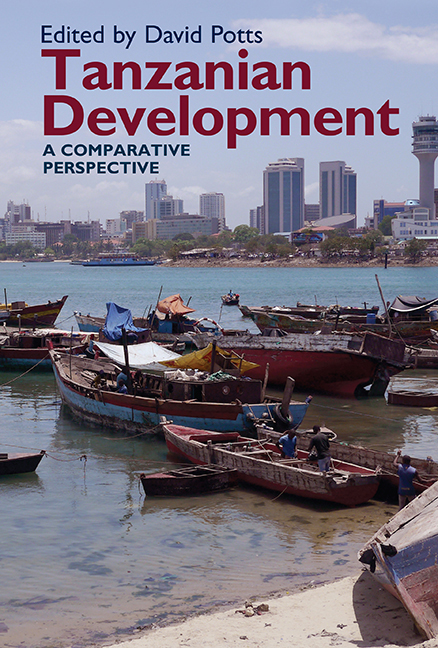Book contents
- Frontmatter
- Contents
- List of Illustrations
- Contributors
- Acknowledgements
- 1 Introduction – Tanzanian Development: A Comparative Perspective
- 2 The Political Economy of Tanzania 1967–2017: Reimagining the State
- 3 Reflections on the Tanzanian Trajectory: Decline and Recovery
- 4 Agricultural Development in Tanzania
- 5 Assets and Poverty Dynamics: The Methodological Challenges of Constructing Longitudinal Surveys in Tanzania
- 6 Contract Farming in Tanzania: Experiences from Tobacco and Sunflower
- 7 ‘We Just Sell Water – That is All We Do’: Two Cases of Small-scale Irrigation in Tanzania
- 8 The Industrial Development of Tanzania in Comparative African Perspective
- 9 Competitiveness in African Manufacturing: Some Evidence from Tanzania
- 10 ‘Good Life Never Comes Like Dreams’: Youth, Poverty and Employment in Arusha
- 11 International Aid to Tanzania – with some comparisons from Ghana and Uganda
- 12 Real Exchange Rate Changes and Export Performance in Tanzania and Ethiopia
- 13 Economic Leakage as a Constraint on Tourism's Effective Contribution to Local Economic Development in Tanzania
- 14 Extractive Industry Revenues and their Expenditure in Local Government Authorities: The Case of the Gold Service Levy in Geita District Council in Tanzania
- 15 Conclusion
- References
- Index
4 - Agricultural Development in Tanzania
Published online by Cambridge University Press: 24 October 2019
- Frontmatter
- Contents
- List of Illustrations
- Contributors
- Acknowledgements
- 1 Introduction – Tanzanian Development: A Comparative Perspective
- 2 The Political Economy of Tanzania 1967–2017: Reimagining the State
- 3 Reflections on the Tanzanian Trajectory: Decline and Recovery
- 4 Agricultural Development in Tanzania
- 5 Assets and Poverty Dynamics: The Methodological Challenges of Constructing Longitudinal Surveys in Tanzania
- 6 Contract Farming in Tanzania: Experiences from Tobacco and Sunflower
- 7 ‘We Just Sell Water – That is All We Do’: Two Cases of Small-scale Irrigation in Tanzania
- 8 The Industrial Development of Tanzania in Comparative African Perspective
- 9 Competitiveness in African Manufacturing: Some Evidence from Tanzania
- 10 ‘Good Life Never Comes Like Dreams’: Youth, Poverty and Employment in Arusha
- 11 International Aid to Tanzania – with some comparisons from Ghana and Uganda
- 12 Real Exchange Rate Changes and Export Performance in Tanzania and Ethiopia
- 13 Economic Leakage as a Constraint on Tourism's Effective Contribution to Local Economic Development in Tanzania
- 14 Extractive Industry Revenues and their Expenditure in Local Government Authorities: The Case of the Gold Service Levy in Geita District Council in Tanzania
- 15 Conclusion
- References
- Index
Summary
Introduction A World Bank report from several years ago (World Bank 2012) stated that, despite Tanzania's reasonable growth performance in recent years, the benefits of growth had flowed insufficiently to rural households. That report painted a dismal picture of agricultural performance, the conventional interpretation of the record. In turn, the view that agriculture has been quite stagnant spurs a search for new approaches to ‘transforming’ agriculture (e.g. through the Southern Agricultural Growth Corridor of Tanzania (SAGCOT)).
This chapter accepts that:
• Since the early 1970s, export crop production has generally performed poorly. The performance of so-called ‘cash’ crops has been one source of the pessimistic view of agricultural performance.
• The gap between rural and urban incomes has widened. However, this is a virtually universal characteristic of economic growth at early stages of development. From the point of view of poverty reduction the rural–urban income gap is less important than the actual growth in rural incomes. In a dynamic economy fast growth is likely to be associated with both a widening urban-rural gap and growing rural incomes.
• Some rural areas have stagnated or even regressed. This is true of Kagera, which, at independence, was one of the most prosperous parts of Tanzania.
• The rate of growth of rural household incomes has fallen short of what is desirable and possibly achievable.
Nevertheless, there have been profound changes and significant progress in many aspects of the rural economy, with a realistic economic response to evolving market opportunities, notably through the expansion of food crop supply to urban areas, and significant progress in living conditions.
If this perception is correct, it is misleading to characterize the rural economy and smallholders as inherently ‘backward’ and unresponsive to potential opportunities. The view sometimes expressed that there is a need for a fundamental change in the ‘mind-set’ of small farmers and promotion of large-scale farming may also be misleading.
The failure of so many agricultural interventions and projects by government and donors cannot be ascribed to an inherent resistance of small farmers to change. It is not small farmers who have failed to identify and exploit potential development opportunities, but rather the ‘experts’ who have designed and implemented flawed rural programmes.
- Type
- Chapter
- Information
- Tanzanian DevelopmentA Comparative Perspective, pp. 58 - 94Publisher: Boydell & BrewerPrint publication year: 2019

